Capturing Snowmelt Runoff Onset Date under Different Land Cover Types Using Synthetic Aperture Radar: Case Study of Sierra Nevada Mountains, USA
Abstract
:1. Introduction
2. Study Area and Data
2.1. Study Area
2.2. Sentinel-1 Data
2.3. In Situ Data
2.4. Land Cover Data
3. Method
4. Results
4.1. Validation of the Extracted ROD
4.2. Interannual Variation in ROD
4.3. SWE’s Control on the ROD
5. Discussion
5.1. Effect of Parameters Besides Wetness on ROD Extraction from SAR Data
5.2. Effect of Sentinel-1 Temporal Resolution on ROD Extraction
5.3. Future Work
6. Conclusions
Author Contributions
Funding
Institutional Review Board Statement
Informed Consent Statement
Data Availability Statement
Acknowledgments
Conflicts of Interest
References
- Hall, D.K.; Riggs, G.A.; Salomonson, V.V. Development of Methods for Mapping Global Snow Cover Using Moderate Resolution Imaging Spectroradiometer Data. Remote Sens. Environ. 1995, 54, 127–140. [Google Scholar] [CrossRef]
- Dietz, A.J.; Kuenzer, C.; Gessner, U.; Dech, S. Remote Sensing of Snow—A Review of Available Methods. Int. J. Remote Sens. 2012, 33, 4094–4134. [Google Scholar] [CrossRef]
- Rittger, K.; Painter, T.H.; Dozier, J. Assessment of Methods for Mapping Snow Cover from MODIS. Adv. Water Resour. 2013, 51, 367–380. [Google Scholar] [CrossRef]
- Bormann, K.J.; Brown, R.D.; Derksen, C.; Painter, T.H. Estimating Snow-Cover Trends from Space. Nat. Clim. Chang. 2018, 8, 924–928. [Google Scholar] [CrossRef]
- Tang, Z.; Deng, G.; Hu, G.; Zhang, H.; Pan, H.; Sang, G. Satellite Observed Spatiotemporal Variability of Snow Cover and Snow Phenology over High Mountain Asia from 2002 to 2021. J. Hydrol. 2022, 613, 128438. [Google Scholar] [CrossRef]
- Han, J.; Liu, Z.; Woods, R.; McVicar, T.R.; Yang, D.; Wang, T.; Hou, Y.; Guo, Y.; Li, C.; Yang, Y. Streamflow Seasonality in a Snow-Dwindling World. Nature 2024, 629, 1075–1081. [Google Scholar] [CrossRef]
- Dharpure, J.K.; Patel, A.; Goswami, A.; Kulkarni, A.V. Snehmani Spatiotemporal Snow Cover Characterization and Its Linkage with Climate Change over the Chenab River Basin, Western Himalayas. Gisci. Remote Sens. 2020, 57, 882–906. [Google Scholar] [CrossRef]
- Huang, X.; Deng, J.; Ma, X.; Wang, Y.; Feng, Q.; Hao, X.; Liang, T. Spatiotemporal Dynamics of Snow Cover Based on Multi-Source Remote Sensing Data in China. Cryosphere 2016, 10, 2453–2463. [Google Scholar] [CrossRef]
- Karas, A.; Karbou, F.; Giffard-Roisin, S.; Durand, P.; Eckert, N. Automatic Color Detection-Based Method Applied to Sentinel-1 SAR Images for Snow Avalanche Debris Monitoring. IEEE Trans. Geosci. Remote Sens. 2022, 60, 1–17. [Google Scholar] [CrossRef]
- Xiao, M. A Warning of Earlier Snowmelt. Nat. Clim. Chang. 2021, 11, 380–381. [Google Scholar] [CrossRef]
- Musselman, K.N.; Addor, N.; Vano, J.A.; Molotch, N.P. Winter Melt Trends Portend Widespread Declines in Snow Water Resources. Nat. Clim. Chang. 2021, 11, 418–424. [Google Scholar] [CrossRef] [PubMed]
- Barnett, T.P.; Adam, J.C.; Lettenmaier, D.P. Potential Impacts of a Warming Climate on Water Availability in Snow-Dominated Regions. Nature 2005, 438, 303–309. [Google Scholar] [CrossRef] [PubMed]
- Biemans, H.; Siderius, C.; Lutz, A.F.; Nepal, S.; Ahmad, B.; Hassan, T.; von Bloh, W.; Wijngaard, R.R.; Wester, P.; Shrestha, A.B.; et al. Importance of Snow and Glacier Meltwater for Agriculture on the Indo-Gangetic Plain. Nat. Sustain. 2019, 2, 594–601. [Google Scholar] [CrossRef]
- Wang, X.; Wang, T.; Guo, H.; Liu, D.; Zhao, Y.; Zhang, T.; Liu, Q.; Piao, S. Disentangling the Mechanisms behind Winter Snow Impact on Vegetation Activity in Northern Ecosystems. Global. Change Biol. 2018, 24, 1651–1662. [Google Scholar] [CrossRef] [PubMed]
- Zheng, J.; Jia, G.; Xu, X. Earlier Snowmelt Predominates Advanced Spring Vegetation Greenup in Alaska. Agric. For. Meteorol. 2022, 315, 108828. [Google Scholar] [CrossRef]
- Dingman, S.L. Physical Hydrology, 3rd ed.; Waveland Press: Long Grove, IL, USA, 2015. [Google Scholar]
- Marin, C.; Bertoldi, G.; Premier, V.; Callegari, M.; Brida, C.; Hürkamp, K.; Tschiersch, J.; Zebisch, M.; Notarnicola, C. Use of Sentinel-1 Radar Observations to Evaluate Snowmelt Dynamics in Alpine Regions. Cryosphere 2020, 14, 935–956. [Google Scholar] [CrossRef]
- Colombo, R.; Garzonio, R.; Di Mauro, B.; Dumont, M.; Tuzet, F.; Cogliati, S.; Pozzi, G.; Maltese, A.; Cremonese, E. Introducing Thermal Inertia for Monitoring Snowmelt Processes With Remote Sensing. Geophys. Res. Lett. 2019, 46, 4308–4319. [Google Scholar] [CrossRef]
- Tsai, Y.-L.S.; Klein, I.; Dietz, A.; Oppelt, N. Monitoring Large-Scale Inland Water Dynamics by Fusing Sentinel-1 SAR and Sentinel-3 Altimetry Data and by Analyzing Causal Effects of Snowmelt. Remote Sens. 2020, 12, 3896. [Google Scholar] [CrossRef]
- Premier, V.; Marin, C.; Bertoldi, G.; Barella, R.; Notarnicola, C.; Bruzzone, L. Exploring the Use of Multi-Source High-Resolution Satellite Data for Snow Water Equivalent Reconstruction over Mountainous Catchments. Cryosphere 2023, 17, 2387–2407. [Google Scholar] [CrossRef]
- Liang, D.; Guo, H.; Zhang, L.; Cheng, Y.; Zhu, Q.; Liu, X. Time-Series Snowmelt Detection over the Antarctic Using Sentinel-1 SAR Images on Google Earth Engine. Remote Sens. Environ. 2021, 256, 112318. [Google Scholar]
- Gao, L.; Zhang, L.; Shen, Y.; Zhang, Y.; Ai, M.; Zhang, W. Modeling Snow Depth and Snow Water Equivalent Distribution and Variation Characteristics in the Irtysh River Basin, China. Appl. Sci. 2021, 11, 8365. [Google Scholar] [CrossRef]
- Karbou, F.; Veyssière, G.; Coleou, C.; Dufour, A.; Gouttevin, I.; Durand, P.; Gascoin, S.; Grizonnet, M. Monitoring Wet Snow Over an Alpine Region Using Sentinel-1 Observations. Remote Sens. 2021, 13, 381. [Google Scholar] [CrossRef]
- Antropova, Y.K.; Komarov, A.S.; Richardson, M.; Millard, K.; Smith, K. Detection of Wet Snow in the Arctic Tundra from Time-Series Fully-Polarimetric RADARSAT-2 Images. Remote Sens. Environ. 2022, 283, 113305. [Google Scholar] [CrossRef]
- Nagler, T.; Rott, H. Retrieval of Wet Snow by Means of Multitemporal SAR Data. IEEE Trans. Geosci. Remote Sens. 2000, 38, 754–765. [Google Scholar] [CrossRef]
- Ulaby, F.; Long, D.; Blackwell, W.; Elachi, C.; Fung, A.; Ruf, C.; Sarabandi, K.; Zyl, J.; Zebker, H. Microwave Radar and Radiometric Remote Sensing; University of Michigan Press: Ann Arbor, MI, USA, 2014. [Google Scholar]
- Nagler, T.; Rott, H.; Ripper, E.; Bippus, G.; Hetzenecker, M. Advancements for Snowmelt Monitoring by Means of Sentinel-1 SAR. Remote Sens. 2016, 8, 348. [Google Scholar] [CrossRef]
- Buchelt, S.; Skov, K.; Rasmussen, K.K.; Ullmann, T. Sentinel-1 Time Series for Mapping Snow Cover Depletion and Timing of Snowmelt in Arctic Periglacial Environments: Case Study from Zackenberg and Kobbefjord, Greenland. Cryosphere 2022, 16, 625–646. [Google Scholar] [CrossRef]
- Torralbo, P.; Pimentel, R.; Polo, M.J.; Notarnicola, C. Characterizing Snow Dynamics in Semi-Arid Mountain Regions with Multitemporal Sentinel-1 Imagery: A Case Study in the Sierra Nevada, Spain. Remote Sens. 2023, 15, 5365. [Google Scholar] [CrossRef]
- Gagliano, E.; Shean, D.; Henderson, S.; Vanderwilt, S. Capturing the Onset of Mountain Snowmelt Runoff Using Satellite Synthetic Aperture Radar. Geophys. Res. Lett. 2023, 50, e2023GL105303. [Google Scholar] [CrossRef]
- Darychuk, S.E.; Shea, J.M.; Menounos, B.; Chesnokova, A.; Jost, G.; Weber, F. Snowmelt Characterization from Optical and Synthetic-Aperture Radar Observations in the La Joie Basin, British Columbia. Cryosphere 2023, 17, 1457–1473. [Google Scholar] [CrossRef]
- Toure, A.M.; Luojus, K.; Rodell, M.; Beaudoing, H.; Getirana, A. Evaluation of Simulated Snow and Snowmelt Timing in the Community Land Model Using Satellite-Based Products and Streamflow Observations. J. Adv. Model Earth. Sy. 2018, 10, 2933–2951. [Google Scholar] [CrossRef]
- Connon, R.F.; Chasmer, L.; Haughton, E.; Helbig, M.; Hopkinson, C.; Sonnentag, O.; Quinton, W.L. The Implications of Permafrost Thaw and Land Cover Change on Snow Water Equivalent Accumulation, Melt and Runoff in Discontinuous Permafrost Peatlands. Hydrol. Process 2021, 35, e14363. [Google Scholar] [CrossRef]
- Liu, C.; Li, Z.; Zhang, P.; Huang, L.; Li, Z.; Gao, S. Wet Snow Detection Using Dual-Polarized Sentinel-1 SAR Time Series Data Considering Different Land Categories. Geocarto Int. 2022, 37, 10907–10924. [Google Scholar] [CrossRef]
- Molotch, N.P.; Meromy, L. Physiographic and Climatic Controls on Snow Cover Persistence in the Sierra Nevada Mountains. Hydrol. Process. 2014, 28, 4573–4586. [Google Scholar] [CrossRef]
- Musselman, K.N.; Molotch, N.P.; Margulis, S.A. Snowmelt Response to Simulated Warming across a Large Elevation Gradient, Southern Sierra Nevada, California. Cryosphere 2017, 11, 2847–2866. [Google Scholar] [CrossRef]
- Zanaga, D.; Van De Kerchove, R.; De Keersmaecker, W.; Souverijns, N.; Brockmann, C.; Quast, R.; Wevers, J.; Grosu, A.; Paccini, A.; Vergnaud, S.; et al. ESA WorldCover 10 m 2020 v100. 2021.
- Vollrath, A.; Mullissa, A.; Reiche, J. Angular-Based Radiometric Slope Correction for Sentinel-1 on Google Earth Engine. Remote Sens. 2020, 12, 1867. [Google Scholar] [CrossRef]
- Rumpf, S.B.; Gravey, M.; Brönnimann, O.; Luoto, M.; Cianfrani, C.; Mariethoz, G.; Guisan, A. From White to Green: Snow Cover Loss and Increased Vegetation Productivity in the European Alps. Science 2022, 376, 1119–1122. [Google Scholar] [CrossRef]
- Baghdadi, N.; Gauthier, Y.; Bernier, M.; Fortin, J.-P. Potential and Limitations of RADARSAT SAR Data for Wet Snow Monitoring. IEEE Trans. Geosci. Remote Sens. 2000, 38, 316–320. [Google Scholar] [CrossRef]
- Magagi, R.; Bernier, M. Optimal Conditions for Wet Snow Detection Using RADARSAT SAR Data. Remote Sens. Environ. 2003, 84, 221–233. [Google Scholar] [CrossRef]
- Shi, J.; Dozier, J. Inferring Snow Wetness Using C-Band Data from SIR-C’s Polarimetric Synthetic Aperture Radar. IEEE Trans. Geosci. Remote Sens. 1995, 33, 905–914. [Google Scholar]
- Surendar, M.; Bhattacharya, A.; Singh, G.; Yamaguchi, Y.; Venkataraman, G. Development of a Snow Wetness Inversion Algorithm Using Polarimetric Scattering Power Decomposition Model. Int. J. Appl. Earth Obs. Geoinf. 2015, 42, 65–75. [Google Scholar] [CrossRef]
- Ma, W.; Xiao, P.; Zhang, X.; Song, Y.; Ma, T.; Ye, L. Retrieving Snow Wetness Based on Surface and Volume Scattering Simulation. ISPRS J. Photogramm. Remote Sens. 2020, 169, 17–28. [Google Scholar] [CrossRef]
- Singh, G.; Venkataraman, G. Snow Wetness Mapping Using Advanced Synthetic Aperture Radar Data. J. Appl. Remote Sens. 2007, 1, 013521. [Google Scholar] [CrossRef]
- Singh, G.; Venkataraman, G. Snow Permittivity Retrieval Inversion Algorithm for Estimating Snow Wetness. Geocarto Int. 2010, 25, 187–212. [Google Scholar] [CrossRef]
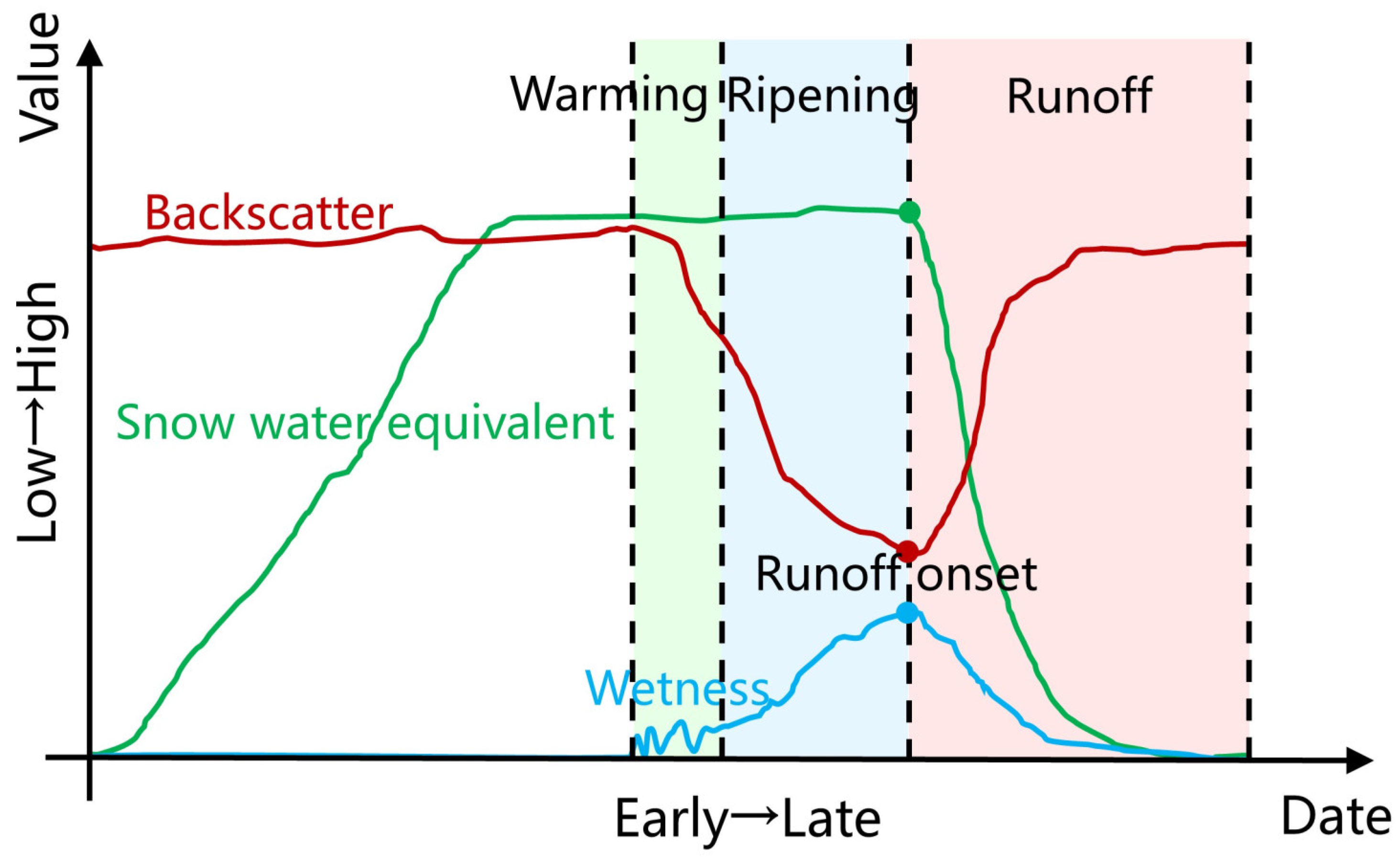
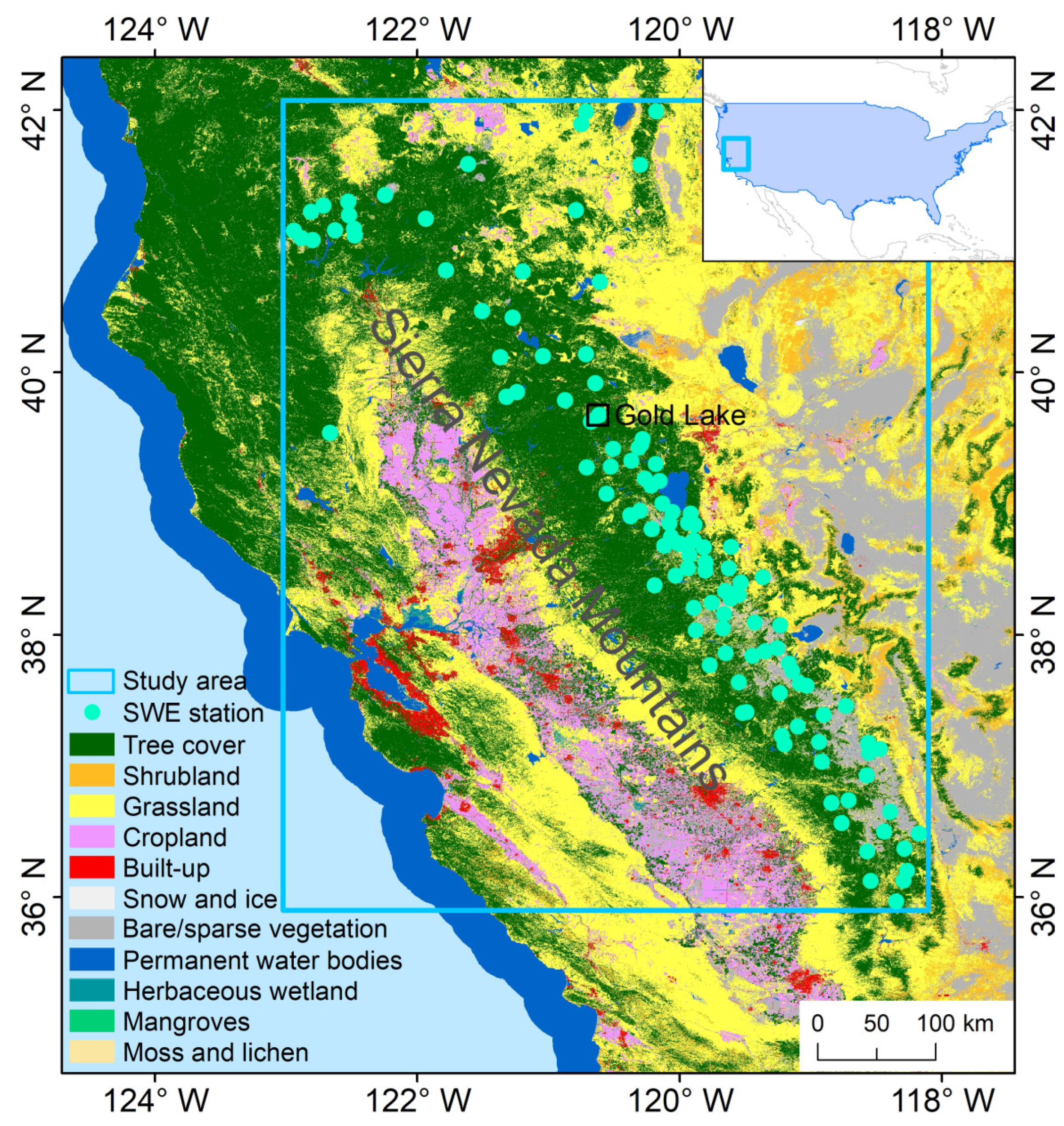


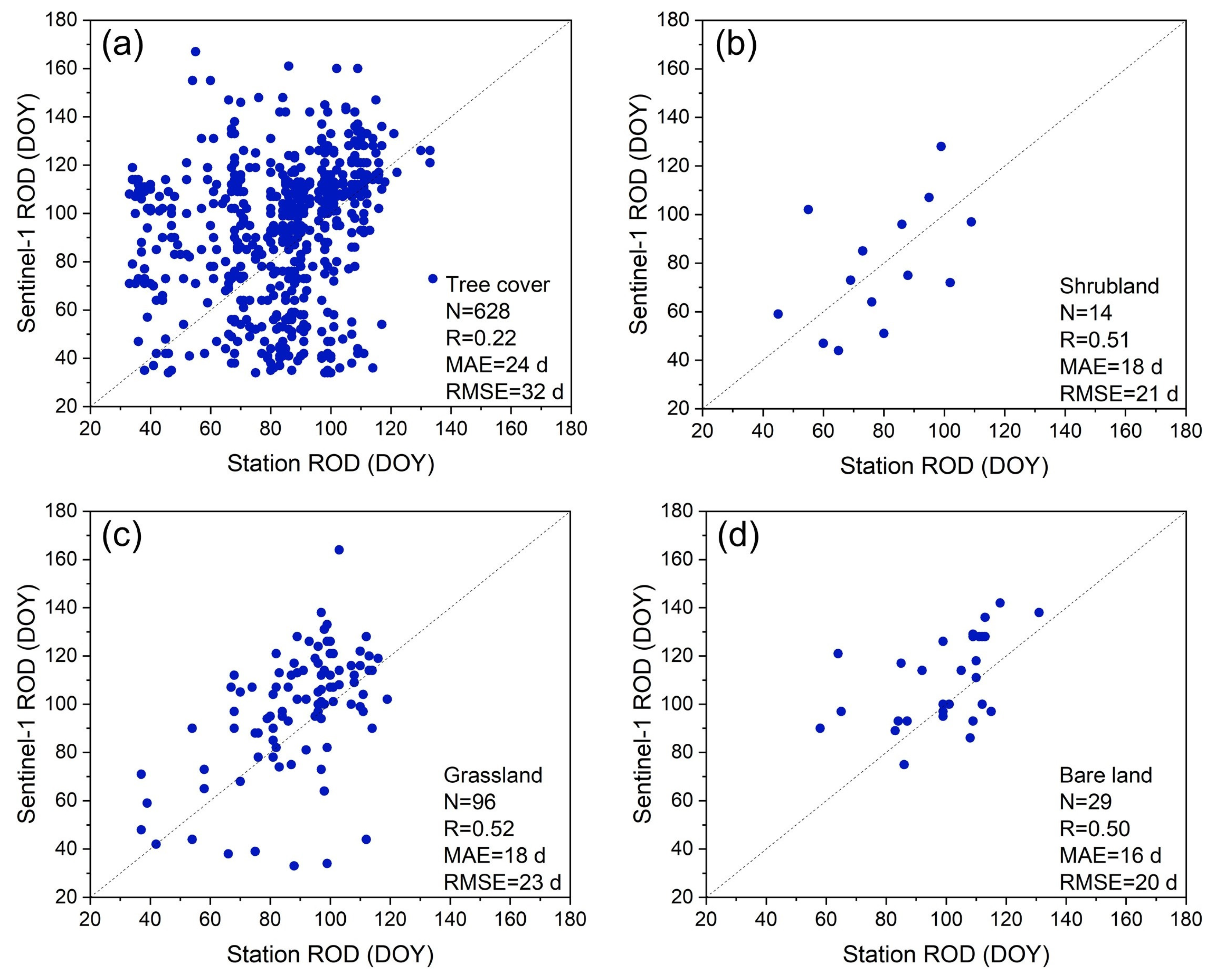
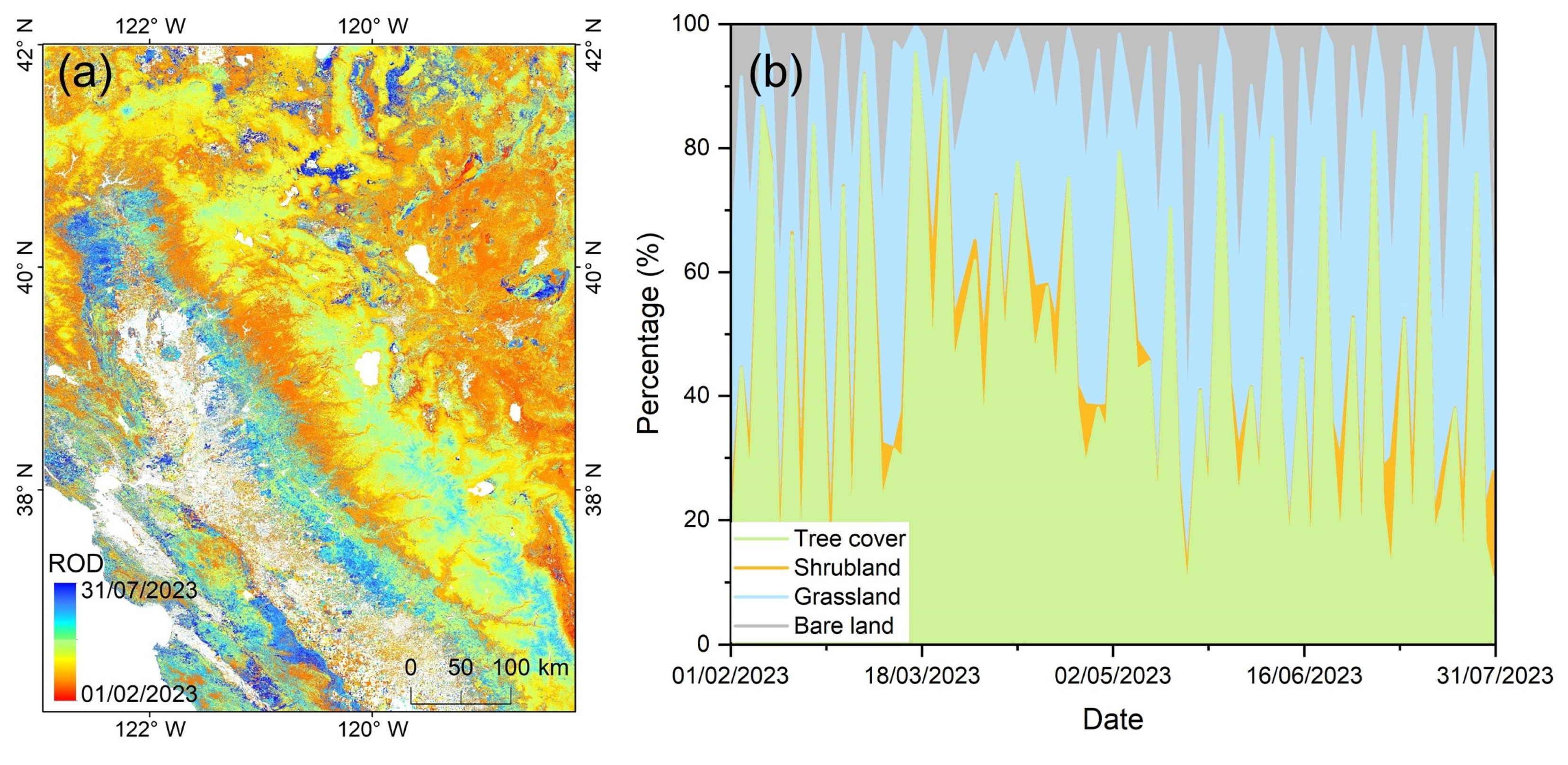
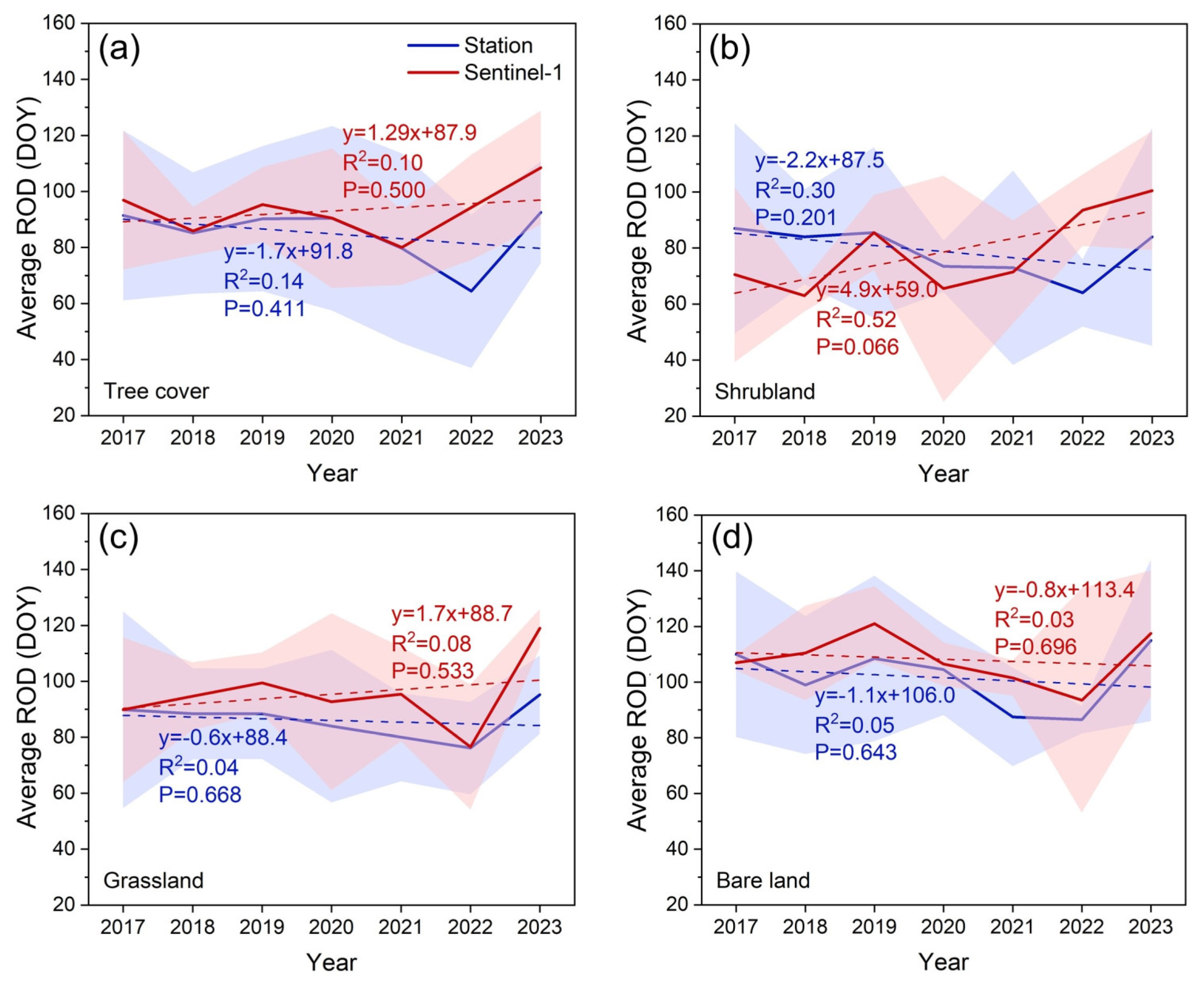
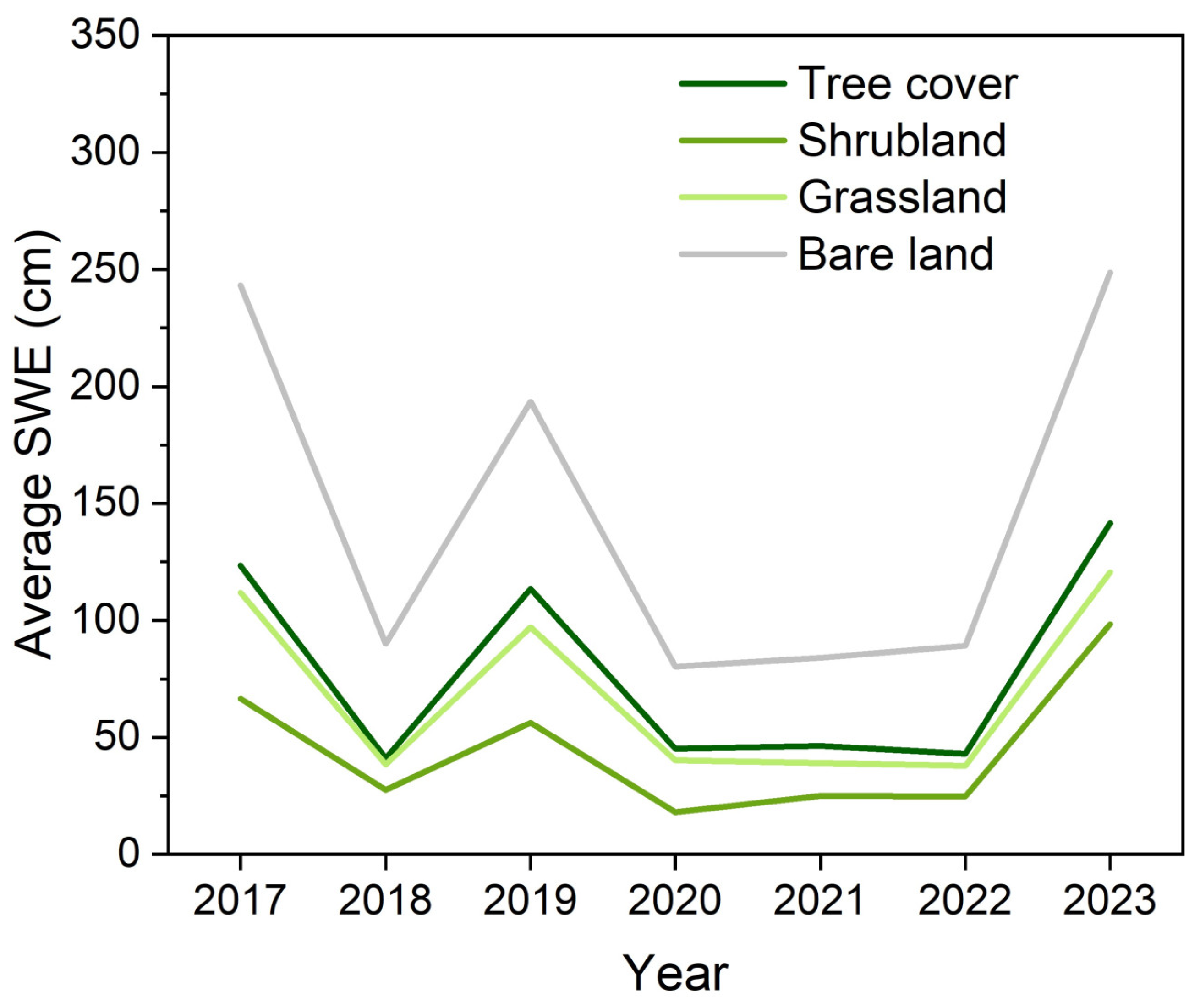
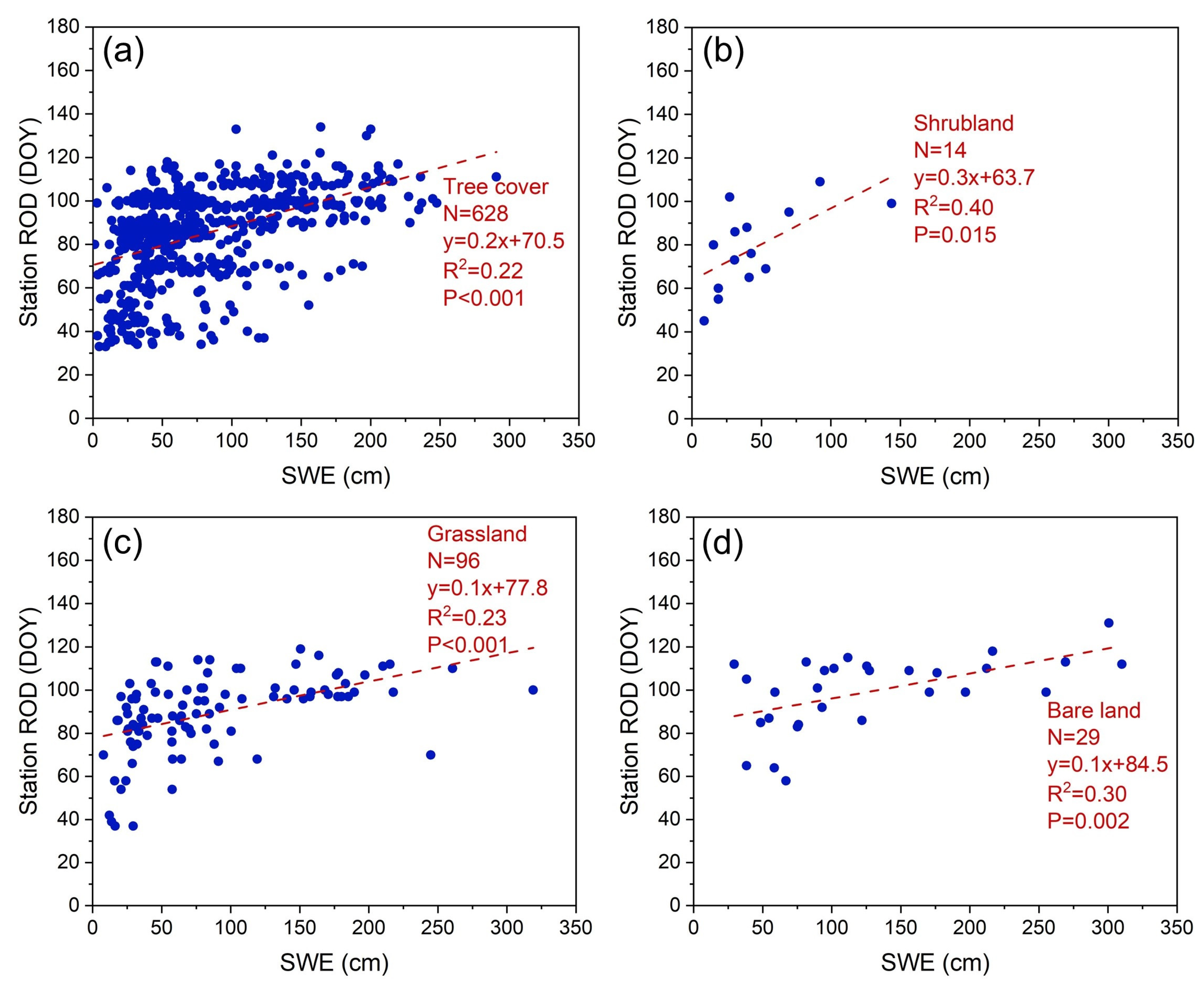

| Year | Number of Stations | Number of Sentinel-1 Images | Number of the Minimum Images Corresponding to the Stations | Number of the Maximum Images Corresponding to the Stations | |||
|---|---|---|---|---|---|---|---|
| Tree Cover | Shrubland | Grassland | Bare Land | ||||
| 2017 | 90 | 2 | 12 | 6 | 332 | 26 | 60 |
| 2018 | 92 | 2 | 14 | 6 | 309 | 21 | 54 |
| 2019 | 95 | 2 | 16 | 4 | 505 | 40 | 86 |
| 2020 | 90 | 2 | 14 | 4 | 626 | 41 | 118 |
| 2021 | 91 | 2 | 14 | 2 | 637 | 44 | 119 |
| 2022 | 87 | 2 | 14 | 4 | 351 | 28 | 59 |
| 2023 | 83 | 2 | 12 | 3 | 357 | 29 | 61 |
| Satellite | Pass | HH:MM (UTC) |
|---|---|---|
| Sentinel-1A | Ascending | 01:59 |
| Descending | 14:07 | |
| Sentinel-1B | Ascending | 01:59 |
| Descending | 14:06 |
Disclaimer/Publisher’s Note: The statements, opinions and data contained in all publications are solely those of the individual author(s) and contributor(s) and not of MDPI and/or the editor(s). MDPI and/or the editor(s) disclaim responsibility for any injury to people or property resulting from any ideas, methods, instructions or products referred to in the content. |
© 2024 by the authors. Licensee MDPI, Basel, Switzerland. This article is an open access article distributed under the terms and conditions of the Creative Commons Attribution (CC BY) license (https://creativecommons.org/licenses/by/4.0/).
Share and Cite
Gao, B.; Ma, W. Capturing Snowmelt Runoff Onset Date under Different Land Cover Types Using Synthetic Aperture Radar: Case Study of Sierra Nevada Mountains, USA. Appl. Sci. 2024, 14, 6844. https://doi.org/10.3390/app14156844
Gao B, Ma W. Capturing Snowmelt Runoff Onset Date under Different Land Cover Types Using Synthetic Aperture Radar: Case Study of Sierra Nevada Mountains, USA. Applied Sciences. 2024; 14(15):6844. https://doi.org/10.3390/app14156844
Chicago/Turabian StyleGao, Bing, and Wei Ma. 2024. "Capturing Snowmelt Runoff Onset Date under Different Land Cover Types Using Synthetic Aperture Radar: Case Study of Sierra Nevada Mountains, USA" Applied Sciences 14, no. 15: 6844. https://doi.org/10.3390/app14156844




